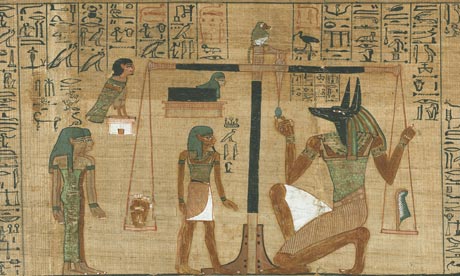Life stretches between birth and dying.
Two portals mark life’s start and end.
Some hold that we will die to ascend
To glory. Others deny such inferring
From scriptures written round the world
That any future awaits our death,
That talk of beyond is wasting our breath.
There is a yearning lying curled
Amid the hopes our hearts hold close
That Paradise is still to be
A destination we will see
When our end occurs for us.

Anubis was the Greek name of Anapa (ı͗npw), a god associated with mummification and the afterlife in ancient Egyptian religion, usually depicted as a canine or a man with the head of an African golden wolf. Depicted as a jackal that protected graves as early as the First Dynasty (ca. 3100 – ca. 2890 BCE), Anubis was also an embalmer: he was given Osiris's organs aftr Seth killed him and helped Isis embalm him. By the Middle Kingdom (ca. 2055 – 1650 BCE) he was replaced by Osiris in his role as lord of the underworld. New Kingdom tomb-seals depicted him sitting atop the nine bows, symbolizing his domination over the enemies of Egypt. By the late pharaonic era (664–332 BCE) he was often depicted guiding individuals across the threshold from the world of the living into the presence of Osiris (sometimes that role was performed by the cow-headed Hathor). In addition, under the scrutiny of the ibis-headed Thoth, he manipulated the scales that determined whether someone was worthy of entering Duat, the realm of the dead, by weighing the heart of the deceased against Ma'at ("truth"); souls heavier than an ostrich feather would be devoured by Ammit, but those lighter would ascend to a heavenly existence. In the Ptolemaic period (350–30 BCE) he was merged with Hermes, becoming Hermanubis, since both gods guided souls to the afterlife; his cultic center was in Cynopolis ("city of dogs"). Anubis was depicted in black, symbolizing both rebirth and the discoloration of the corpse after embalming. His female counterpart was Anput, and his daughter the serpent goddess Kebechet. He was associated with Wepwawet, another Egyptian god portrayed with a dog's head or in canine form but with grey or white fur. In early mythology he was portrayed as a son of Ra, but in the First Intermediate Period (ca. 2181–2055 BCE) he was the son of either the cow goddess Hesat or the cat-headed Bastet. In other traditions he was the son of Nephthys an Ra, though in the first century Plutarchus claimed he was the illegitimate son of Nephthys and Osiris but that he was adopted by Osiris's wife Isis after she "found out that Osiris loved her sister and had relations with her in mistaking her sister for herself." In one myth Set tried to attack the body of Osiris by transforming himself into a leopard, but Anubis prevented the desecrtion and branded Set's skin with a hot iron rod and flayed him.
ReplyDelete